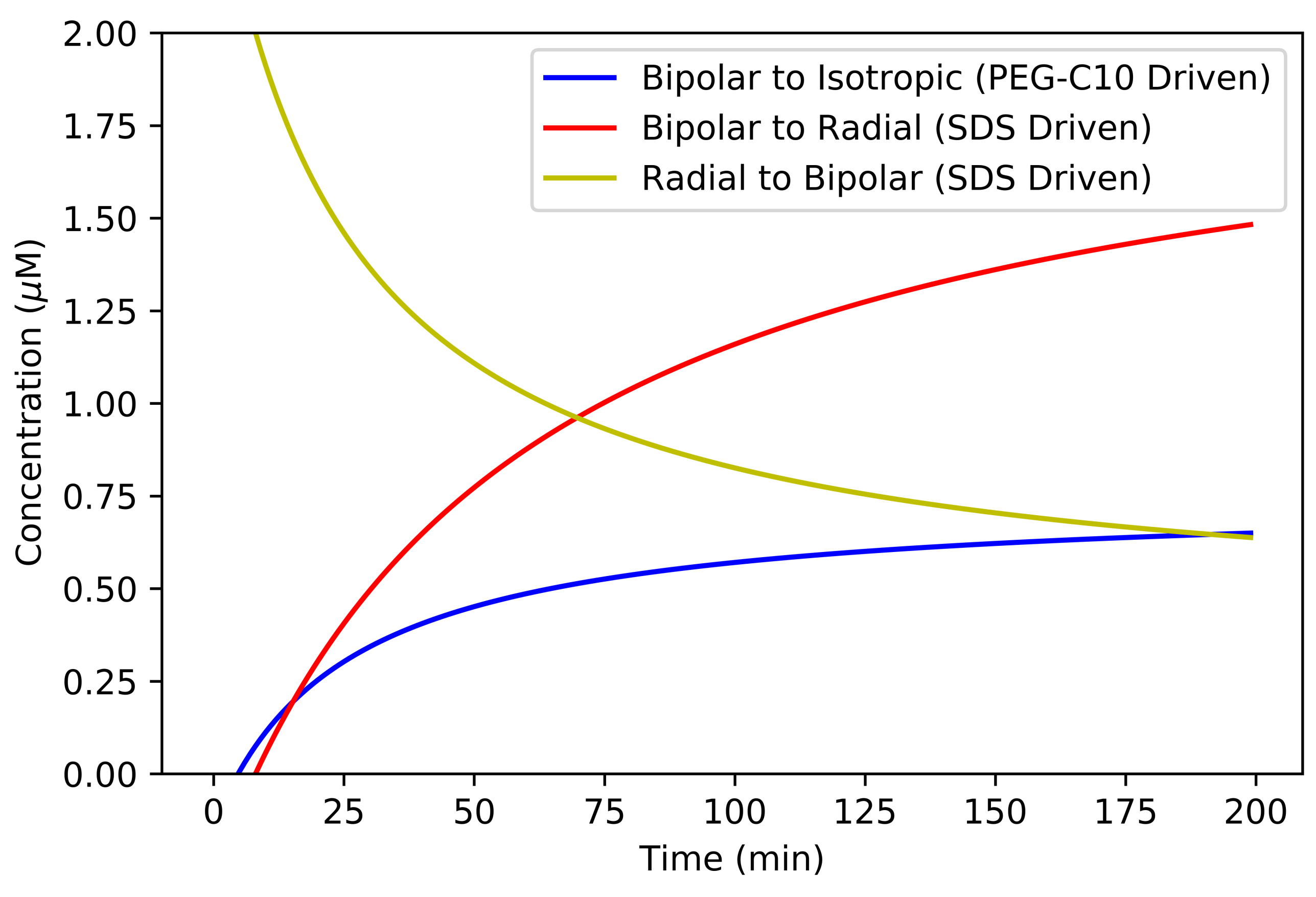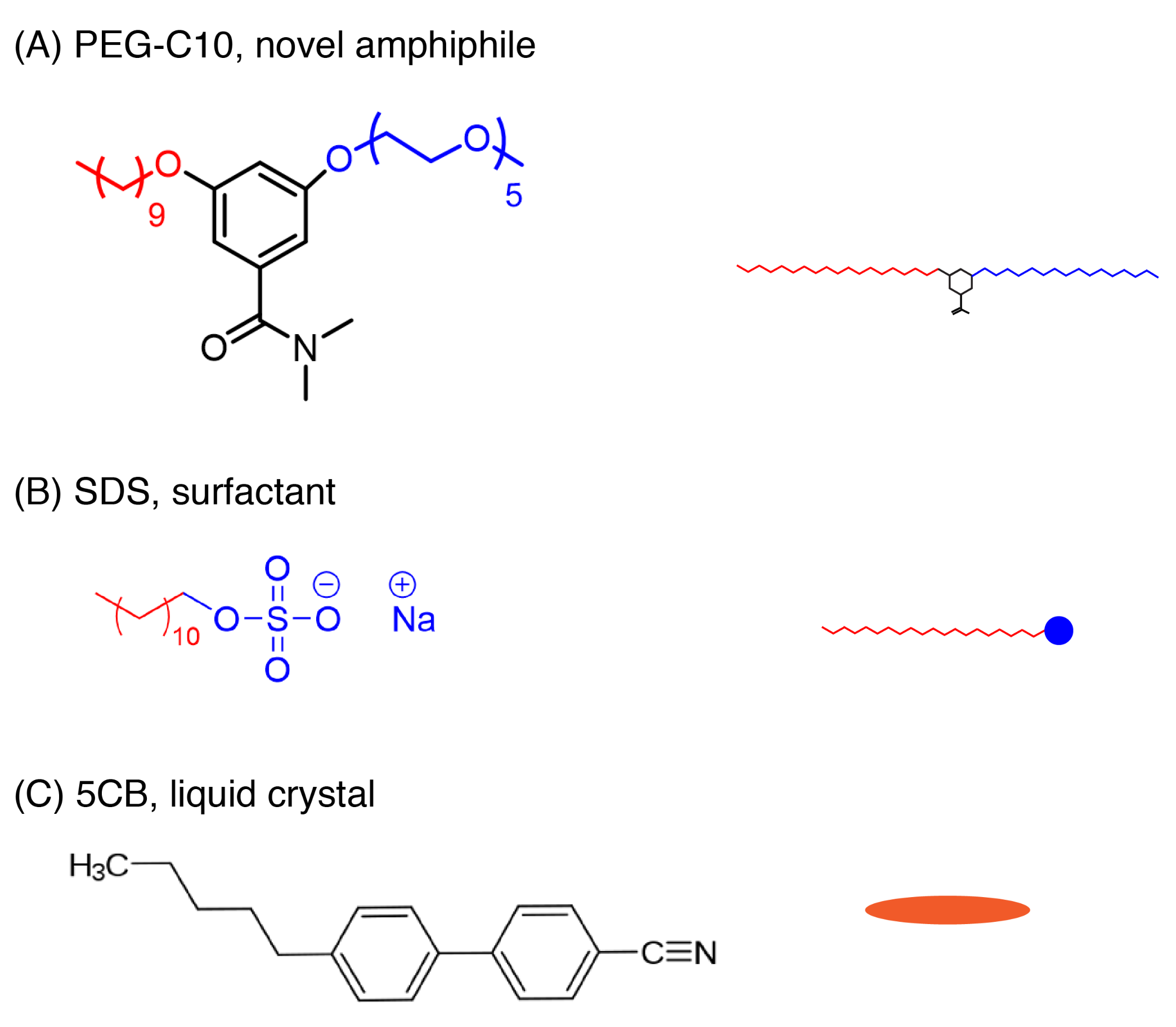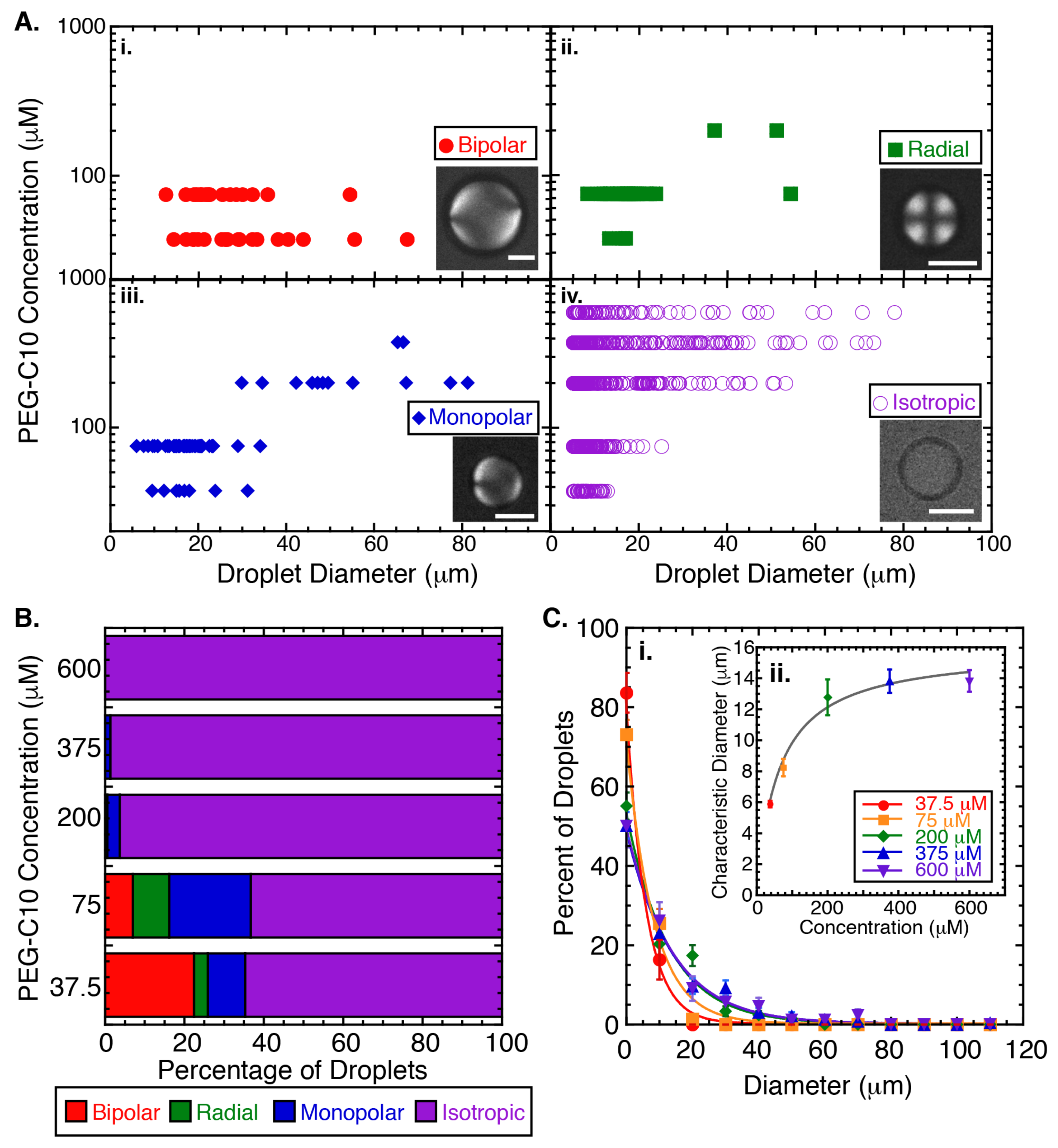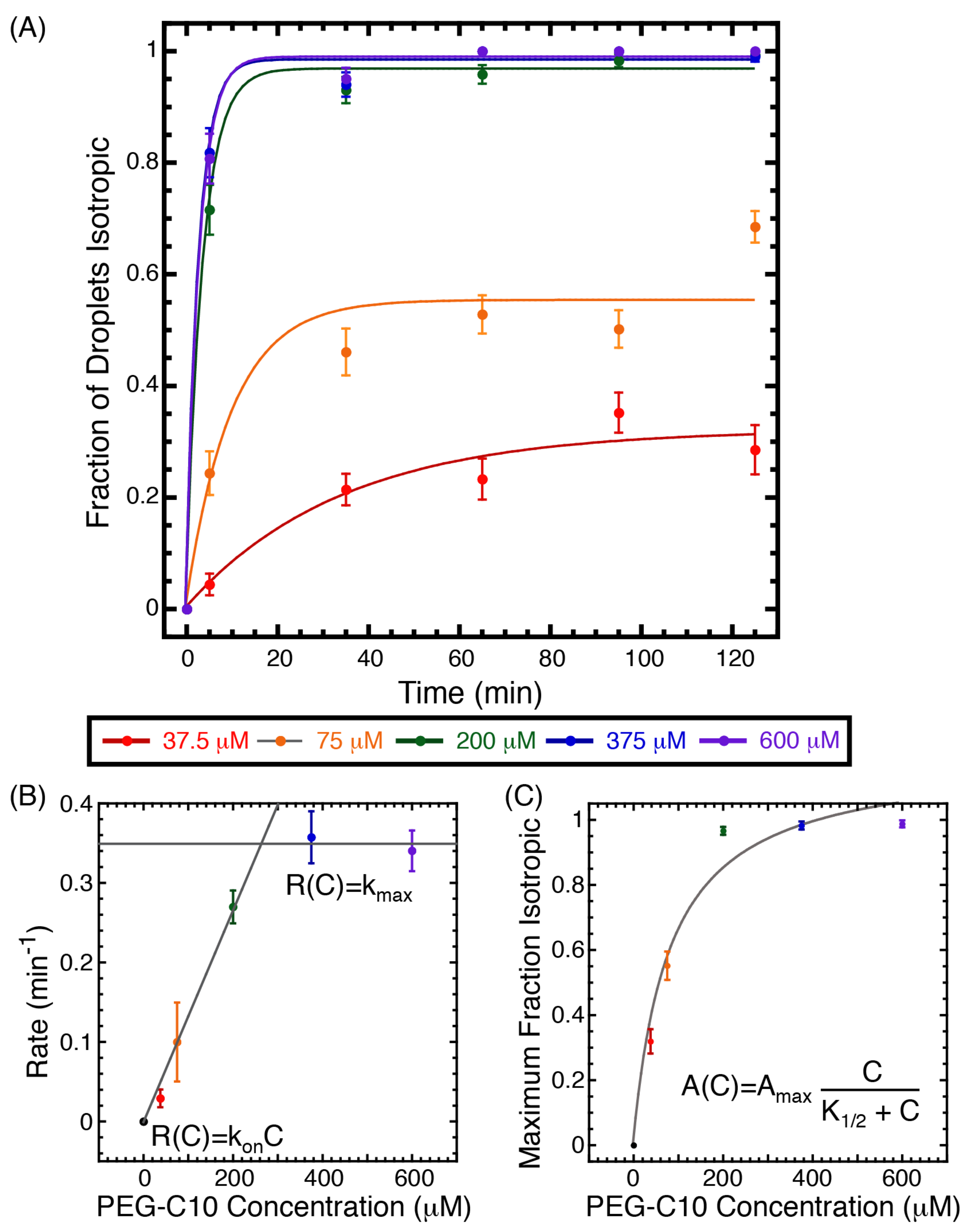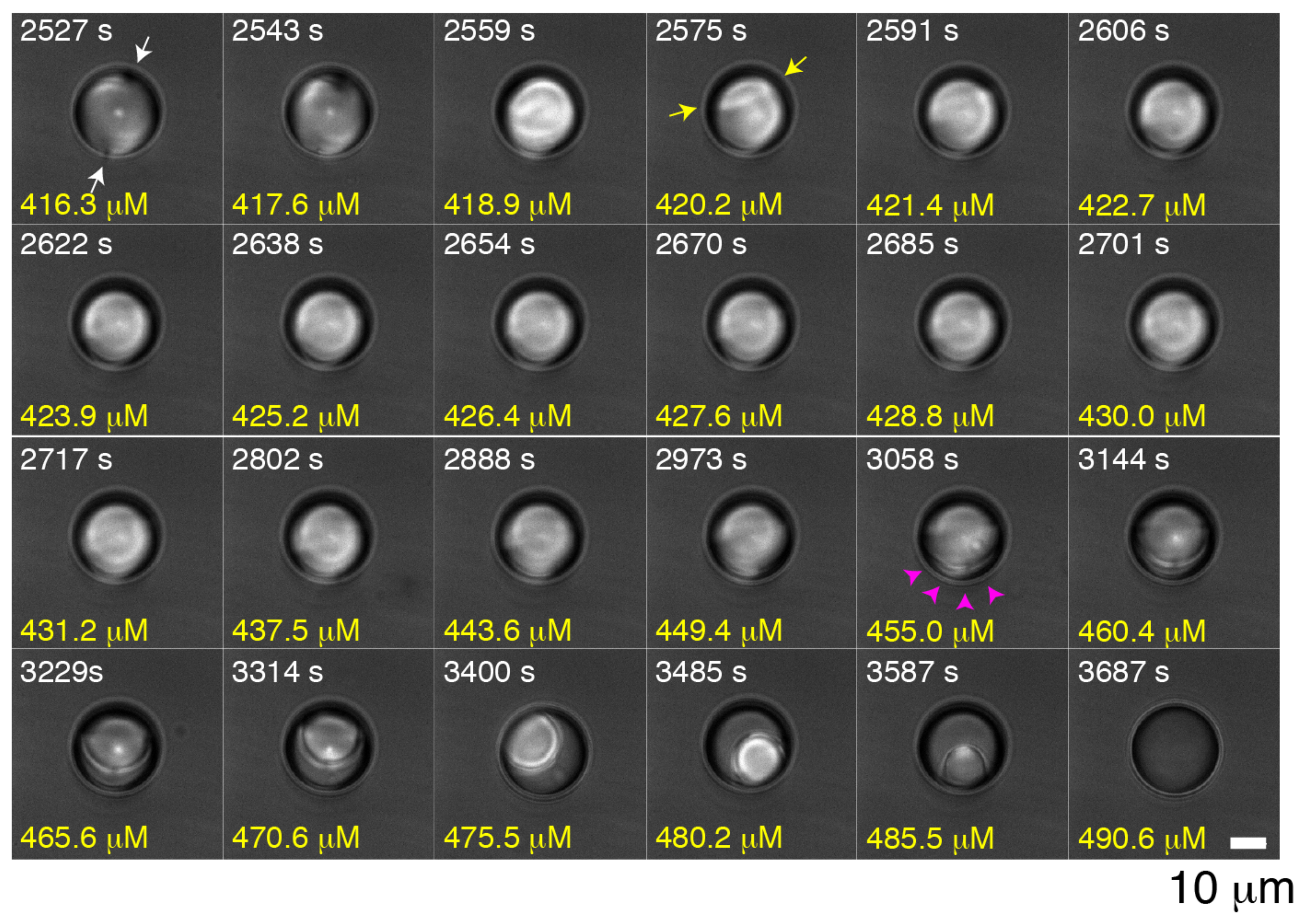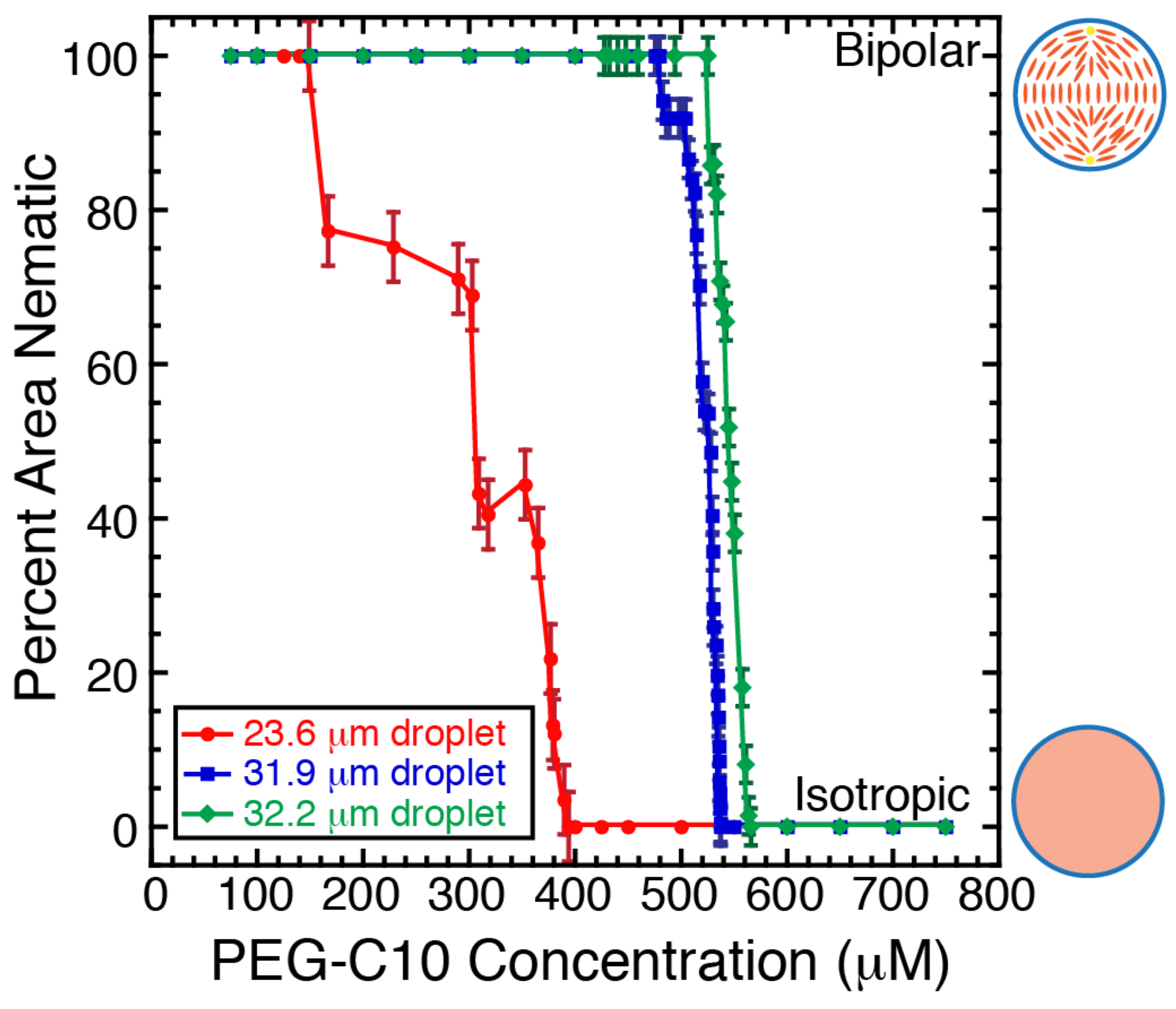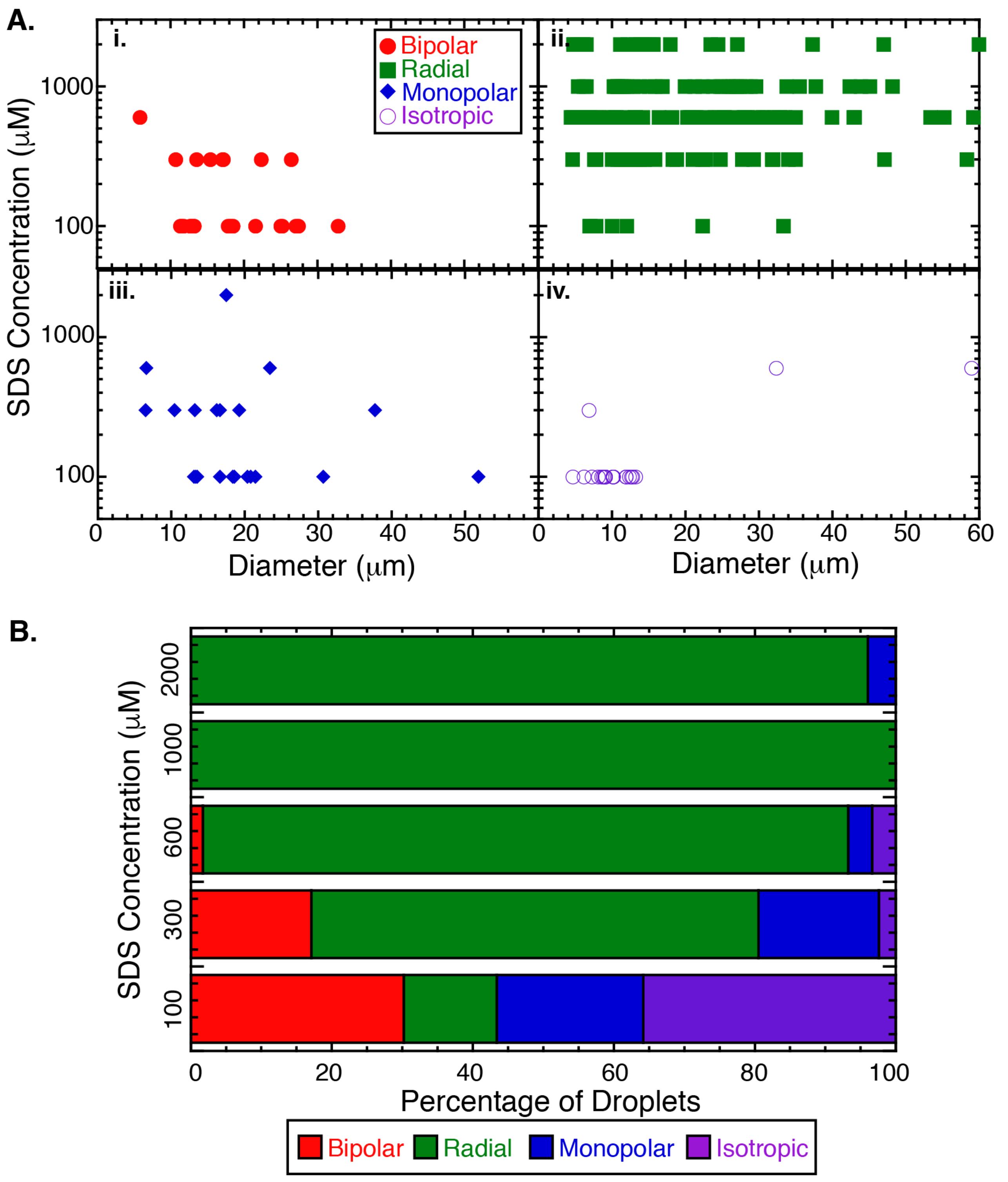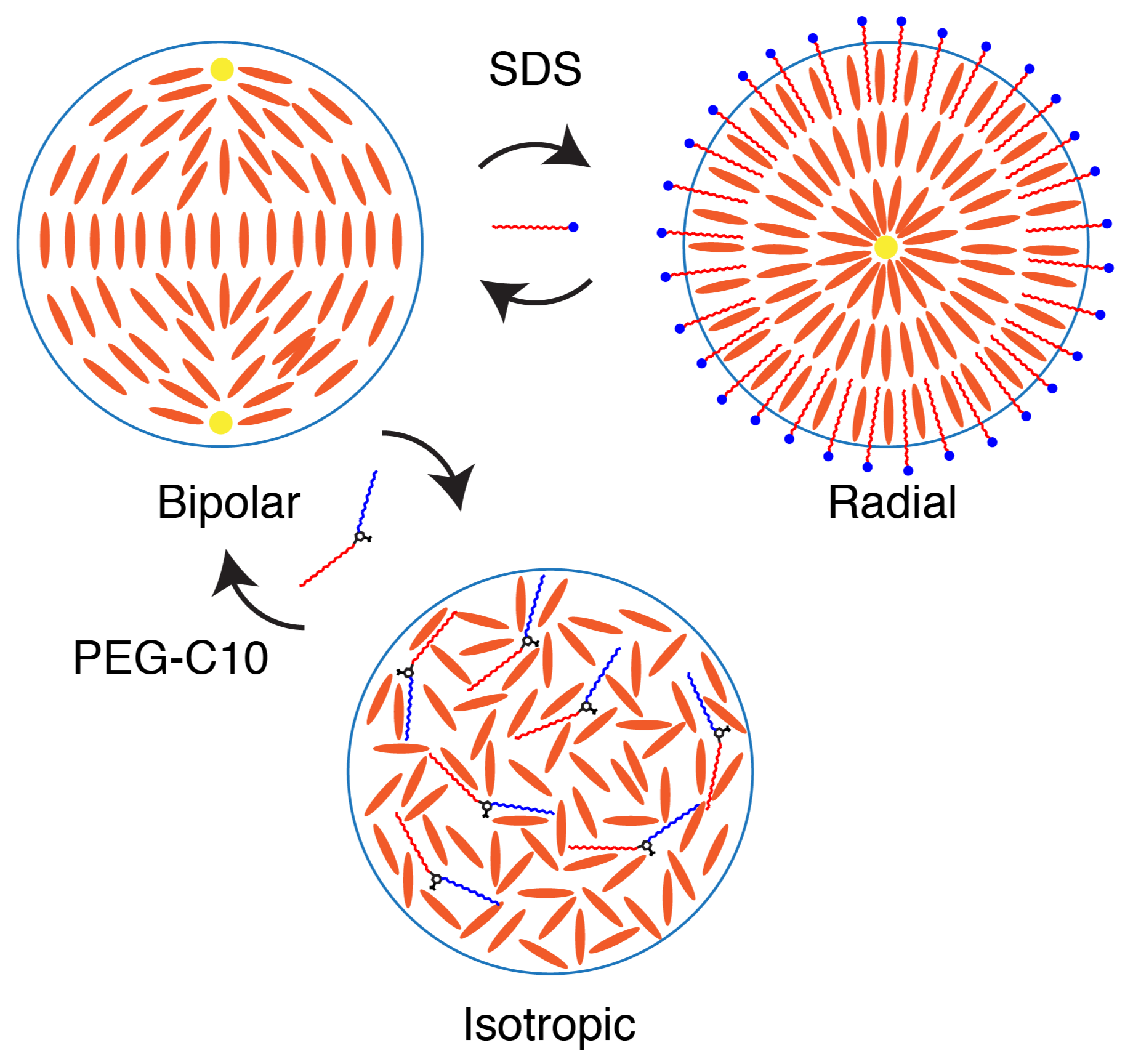3.1. PEG-C10 Phase Diagram
Our initial experiments seek to determine the phase of liquid crystal droplets in the presence of a novel oligomeric amphiphile, PEG-C10, using the following static concentrations: 37.5, 75, 200, 375, and 600 μM. Using crossed polarizers, we image the droplets and classify each as being in the bipolar configuration (
Figure 2A(i)), radial configuration (
Figure 2A(ii)), monopolar configuration (
Figure 2A(iii)), or isotropic phase (
Figure 2A(iv)). The droplets are incubated for two hours and only droplets larger than 5 μm in diameter are included in analysis.
From the phase diagram, it is clear that the isotropic phase is the favored phase for all the concentrations of PEG-C10 tested (
Figure 2A,B,
Appendix B.1:
Table A1). Of the fraction of droplets that display the nematic phase, the configuration of the liquid crystal in the droplets follows the same pattern we have observed previously for SDS surfactant. Specifically, for nematic droplets, the initial configuration is mostly bipolar and changes to monopolar and radial. This is the expected transition for surfactants that stay at the boundary and affect the liquid crystal orientation inside the droplets [
21].
The fraction of droplets that are in the isotropic phase is notably high for all PEG-C10 concentrations examined (
Figure 2A,B). At the three highest concentrations, almost 100% of the droplets are in the isotropic phase, independent of the size of the droplet (
Figure 2A). For the lower PEG-C10 concentrations, the smaller droplets are more likely to be isotropic than larger droplets (
Figure 2A). We created normalized histograms of the diameters of isotropic droplets (
Figure 2C(i)). All histograms appear to decay exponentially, likely due to the agitation method we use to the create droplets. We fit the data to an exponential decay function of the form:
= A
to determine the characteristic diameter size,
of the isotropic droplets (
Figure 2C(i), fit data given in
Appendix B.1:
Table A2).
Using the characteristic size of the isotropic droplet,
, at each concentration, we can see that it increases monotonically with PEG-C10 concentration and appears to saturate (
Figure 2C(ii)). We fit this data to a hyperbolic function of the form:
where
is the asymptote of the function at large
x, and
k denotes the concentration when
y is half of
(best fit information given in
Appendix B.1:
Table A3). Here, the maximum value denotes the characteristic diameter of the droplets due to the method of creating the droplets using agitation, since 100% of the droplets are isotropic at the highest concentrations.
The second fit parameter, k, denotes the concentration of PEG-C10 where the diameter of isotropic droplets is half the maximum. This concentration is likely also the concentration when half the droplets would change to isotropic, assuming that they are in equilibrium. All of the data shown here were taken at the same 2 h time point, but we cannot say for sure that we are in the equilibrium configuration. In order to examine the rate of change from nematic to isotropic, we need to quantify the configuration of the droplets over time.
3.2. Dynamics of LC Phase in the Presence of PEG-C10
The above data are taken after two hours incubation with a fixed concentration of PEG-C10. We seek to understand if the final state is steady state and how quickly the steady-state configurations are established. In order to do this, we monitor the configuration state, focusing on the isotropic configuration, of a set of droplets over time for up to two hours (
Figure 3). We test PEG-C10 concentrations of 37.5, 75, 200, 375, and 600 μM. Any droplets that did not maintain a spherical shape were discarded from the measurement. The information about the number of measurements for each time point and concentration is given in
Appendix B.2:
Table A4.
The percentage of isotropic droplets increased for each sample over time reaching a saturation level that was lower for the smaller PEG-C10 concentrations (37.5 and 75 μM) and plateaued at almost 100% for the higher concentrations (200, 375, and 600 μM) (
Figure 3A). Each of the plots was fit to a rising exponential decay with this form:
where
is the percent of droplets that were isotropic over time,
t;
A is the asymptotic level of the equilibrium amount of isotropic droplets;
R is the rate of change to isotropic. The parameters for the best fit of each fixed concentration are given in
Appendix B.2:
Table A5. Comparing these asymptotic maximum values from the dynamic data (
Figure 3A) to the percentage of droplets that were isotropic in the equilibrium data (
Figure 2B), we see the same trend, although the exact quantitative values are slightly different. That could be due to differences in preparations or times of analysis.
Using the fit to Equation (
3), we can see that both the rate of change from nematic to isotropic,
R, and the expected equilibrium value for the percentage of droplets that are isotropic,
A, depend on the concentration of PEG-C10 (
Figure 3B,C). Examining the rate of change,
R, we note that it increases linearly for low surfactant concentrations and plateaus at higher surfactant concentrations (
Figure 3B). If we fit a line to the linear portion with form:
, where
C is the amphiphile concentration, and
is the one-rate, we find the on-rate is best given by 0.00133 ± 0.00005 (M-min)
(Ms)
(
Figure 3B). Comparing this rate to the expected rate for aqueous diffusion-limited on-rates, we find it is about an order of magnitude slower than expected [
25]. Most likely, this rate represents the rate of penetration of the amphiphile into the droplet interior, which results is melting the nematic to the isotropic phase.
At the two highest concentrations of PEG-C10 molecules, the transition rate,
R, plateaus at a maximum of 0.35 min
(
Figure 3B, horizontal line). This implies that at these highest concentrations, the PEG-C10 is no longer limiting the reaction; these concentrations can be considered saturating. Further, we can be confident that, at these concentrations, the data are at equilibrium, and the on and off rates (both measured in Hz) are equal to 21 Hz. This rate is also surprisingly slow, implying affinity between the PEG-C10 molecules and the 5CB.
Examining the asymptotic amplitudes for the fraction of droplets that are isotropic over time,
A, we observe a monotonic increase with concentration (
Figure 3C). Thus, the more oligomeric amphiphile present, the more droplets are isotropic at equilibrium. This corresponds to the data from the phase diagram (
Figure 2B,C). These data also suggest that the two-hour time point used for steady-state measurements was acceptable as a final time point for equilibrium. The maximum
A appears to plateau at 200 μM PEG-C10 (
Figure 3C), where almost 100% of the droplets are in the isotropic phase at equilibrium. Aqueous reactions depend on the concentration of the reactants hyperbolically with the form:
where
is the maximum fraction of droplets that are isotropic as a function of PEG-C10,
C, at long times (the asymptote of the data in (
Figure 2A)),
is the maximum amplitude plateau, which is constrained to be 100% by the experiment, but is a free-floating parameter of the fit, and
which is the concentration where 50% of the droplets are isotropic. When the
is able to be a fit parameter, the best-fit value was 119% ± 9%. In this case, the best-fit value of
is 80 ± 20 μM. If we fixed the
to 100%, the
value becomes 50 ± 10 μM, which is a more reasonable value, given the data. Comparing these two different fits, the
value is lower when the
is higher (see fit parameters in
Appendix B.2:
Table A6). The characteristic concentration for the transformation from nematic to isotropic,
50–80 μM PEG-C10, should be the most sensitive for controlling the transition.
3.3. Dynamic PEG-C10 Effects on Individual Liquid Crystal Droplets
The data show that the fraction of droplets that are isotropic increases with concentration, that the smallest droplets are more likely to be isotropic (
Figure 2), and the the fraction of droplets that are isotropic increases with time (
Figure 3), all suggest that the PEG-C10 amphiphile is causing the transition from nematic to isotropic by entering the droplet from the aqueous phase into the liquid crystal. In order to directly observe the transition for a single droplet, we use an optical trap to hold a liquid crystal droplet while the background fluid is changed. This allows us to directly observe any configurational or phase changes that might occur due to the addition of the PEG-C10. The concentration of the PEG-C10 was changed from 75 to 750 μM and only larger droplets were used (>20 μm in diameter).
Each droplet begins in the bipolar configuration with two poles on opposite sides (i.e.,
Figure 4, 2527 s, 416.3 μM, white arrows). This is the configuration expected with little surfactant on the surface—just enough to keep the droplets from coalescing. As the concentration increases, one of the two bipolar defects becomes a traveling ring defect (
Figure 4, 2575 s, 420.2 μM, yellow arrows). In our prior work, a traveling ring defect was predicted from simulations of liquid crystals in droplets. We used this optical trapping technique to directly observe the traveling ring defect when droplets transitioned from bipolar to radial configurations and compared this to theoretically predicted intermediate configurations [
21].
Unlike our prior results with SDS where a radial configuration followed the ring defect motion [
21], here, in the presence of PEG-C10, the nematic phase stays in an intermediate state. Interestingly, radial droplets are observed in the steady-state configuration diagram (
Figure 2A,B) at both 37.5 and 75 μM PEG-C10 and mostly observed in droplets with diameters between 5 and 20 μm. We do not see the radial configuration at higher concentrations. Since we use larger droplets for optical trapping experiments, we start the concentration of PEG-C10 at 75 μM, and we require the droplet to be in the bipolar configuration to start, it is not surprising that we do not see the radial configuration. Indeed, these dynamics data imply that the liquid crystal might need to be a smaller volume for the 75 μM PEG-C10 to enable the radial configuration.
Instead of becoming radial, the droplet stays in an intermediate configuration until the nematic phase begins to melt, becoming an isotropic phase (
Figure 4, 3058 s, 455.0 μM, pink arrows). We directly observe the front of the phase transition from nematic liquid crystals to isotropic—this is the boundary between the ordered and melted states. The front moves from the edges of the droplet to the center until the droplet is completely melted. Because droplets are free to rotate even when held by optical tweezers, the spherical nematic region appears to change position throughout time series (i.e.,
Figure 4, 3144–3587 s frames). We cannot control the rotation of the droplet using the optical trap system here, but if the polarization of the incident beam were modified, the location, rotation, and speed of the rotation could be modified in future studies. In the current study, the location of the nematic region within the droplet is purely incidental, although we notice that the nematic phase often stays to one side so that it is in contact with the aqueous phase of the emulsion. This may suggest that the nematic phase has a higher surface affinity for the aqueous interface over the isotropic portion of the droplet.
Using the images of the droplets in the optical trap, we measure the projected size of the nematic region over time. Specifically, we measure the diameter and calculate a projected nematic area (μm
). We normalize the nematic area measurement by dividing by the total projected area of the droplet. Since we know the relationship between the time in the movie and the concentration of PEG-C10 added (Equation (
1)), we can plot the fraction of droplet that is in the nematic phase as a function of the PEG-C10 concentration (
Figure 5). For two larger droplets (∼32 μm diameter), the initial PEG-C10 of transformation and the rate of transformation are similar, and the rate of melting transition appears fairly constant. It appears that the smaller droplet transitions before the larger ones with a less consistent rate of melting. As the radius of the droplet decreases, the surface area to volume ratio increases, so it is expected that the smaller droplet should transform before larger droplets. The same trend was observed in the phase diagrams that showed that smaller droplets at low PEG-C10 concentrations were more likely to be isotropic than larger droplets (
Figure 2C).
The concentrations of the transition we measure for the trapped droplets are far higher than the
concentrations needed to cause the transition in half the droplets. We would expect such large droplets to take longer to change, but even a lower concentration of PEG-C10, such as 200 μM should be able to cause the change (
Figure 2 and
Figure 3). Indeed, that is the concentration that triggers the smaller droplet to change (
Figure 5, red). For the larger droplets, by the time the melting is visible, the concentration is already saturating, as seen from the dynamic experiments (
Figure 3). Thus, the transition appears to occur fast, but in reality it was already delayed compared to expectations from equilibrium measurements. That delay could be due to the time to shift the concentration in the experiment or a lag in the transition due to the droplets being so large and amount of PEG-C10 needed to penetrate the droplet to cause the change.
3.4. Configuration of Droplets in the Presence of SDS and PEG-C10
Our results above show that the addition of our oligomeric amphiphile PEG-C10 molecules results in two distinct transitions of the liquid crystal configuration. First, there is a rapid surface-induced transition. That resulted in the bipolar configuration changing to the monopolar configuration. After that, the surfactant acts to disrupt ordering in the droplet by penetrating the droplet in a diffusion-limited manner. In our dynamic studies using the optical trap, we were not able to reverse the state from isotropic back to nematic through dilution. Instead, we propose that a second surfactant could be applied to alter the state of the droplets. We have previously successfully worked with SDS as a surfactant to trigger droplet configuration changes [
21]. Here, we mix SDS with the PEG-C10 to determine if the SDS can reverse or overpower the phase change induced by the PEG-C10.
We first characterize the steady-state morphology of droplets at fixed SDS and PEG-C10 concentrations, 50 μM, near measured
. We alter the SDS concentrations in solution: 100 μM, 300 μM, 600 μM, 1 mM, and 2 mM. These concentrations are chosen to be well below the critical aggregate concentration (CAC) of SDS, 10 mM (
Figure 6). At the lowest SDS concentration, 100 μM, the majority of droplets are isotropic (
%) or bipolar (
%), implying that this low concentration of SDS could not fully inhibit the effects of the PEG-C10 (
Figure 6). Increasing the SDS concentration to 300 μM decreases the incidence of isotropic droplets to only
%. The majority of droplets at 300 μM are in the radial configuration (
). At 600 and 1000 μM SDS, nearly all droplets are radial (
% and 100% respectively) and no isotropic droplets were found at 1 and 2 mM SDS.
